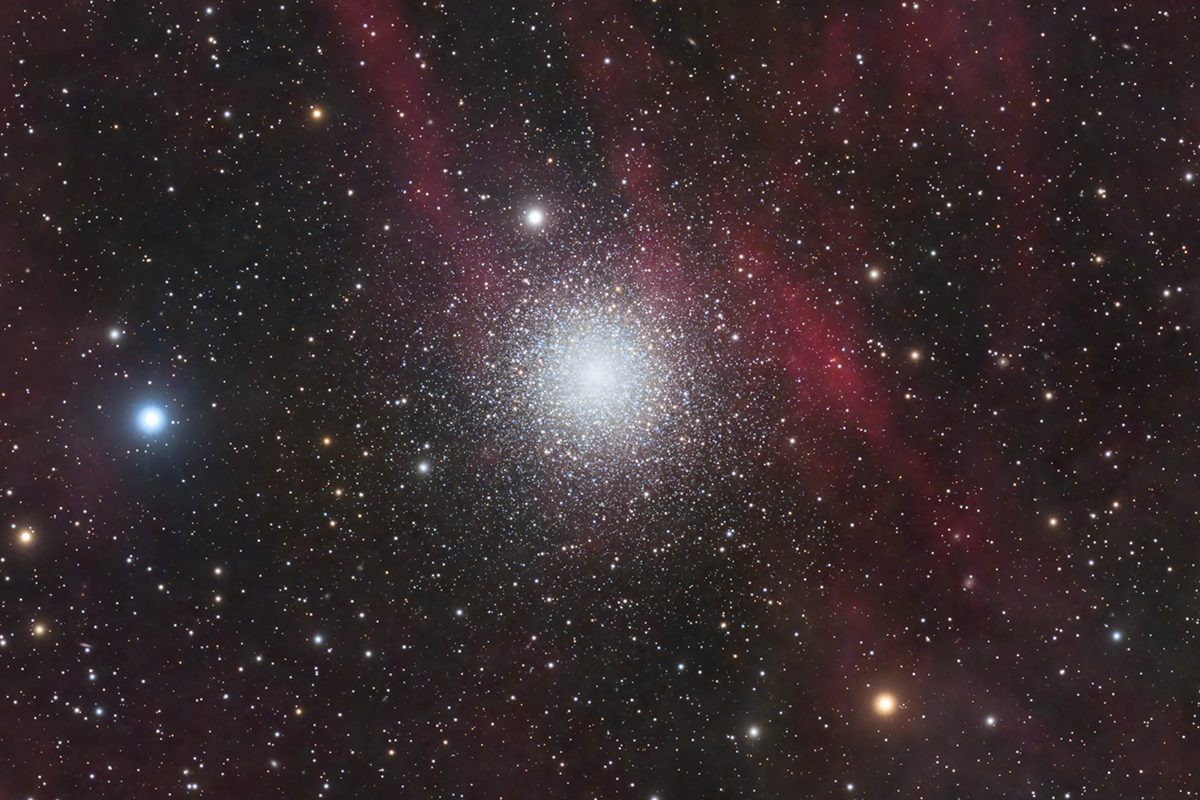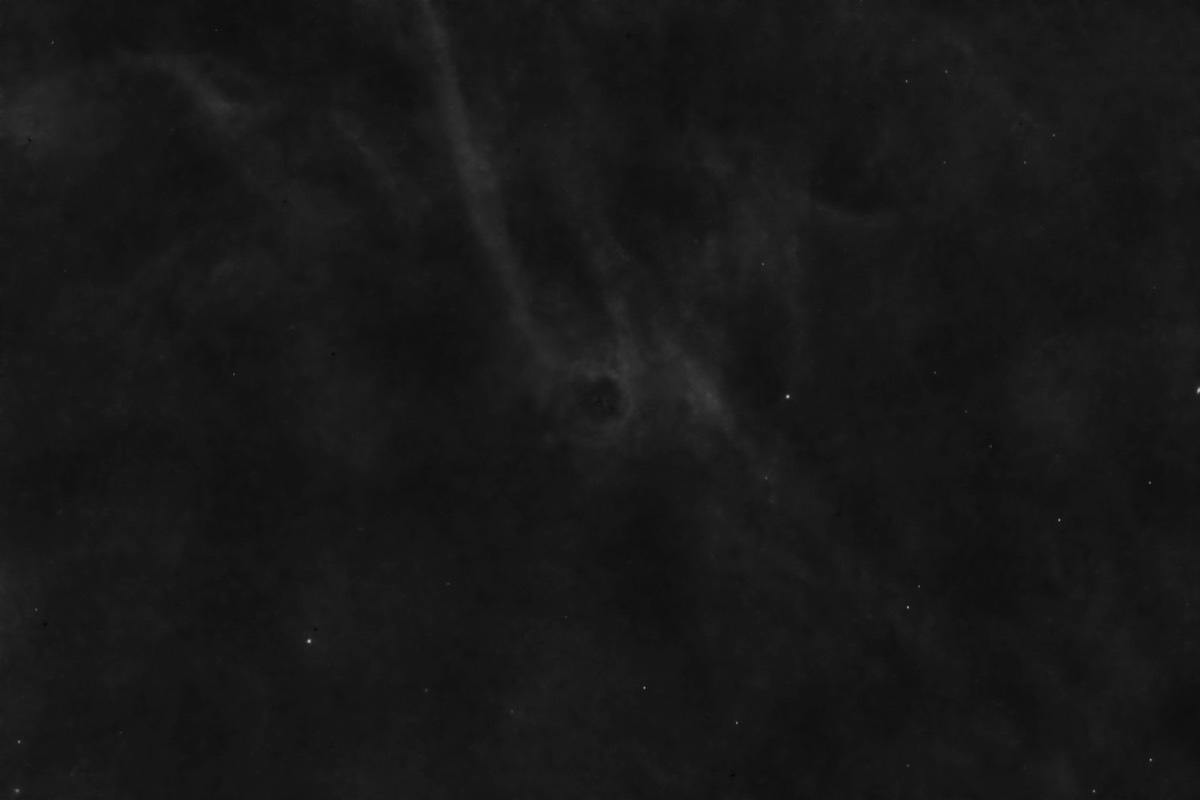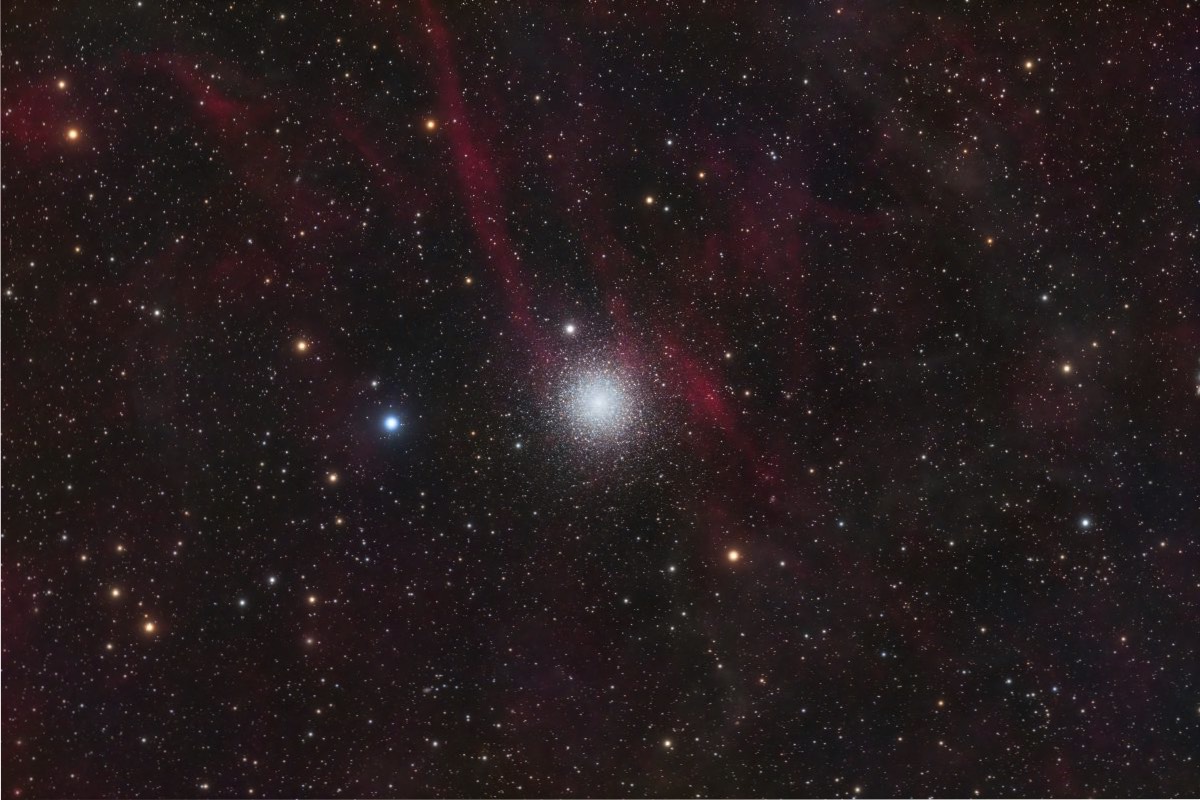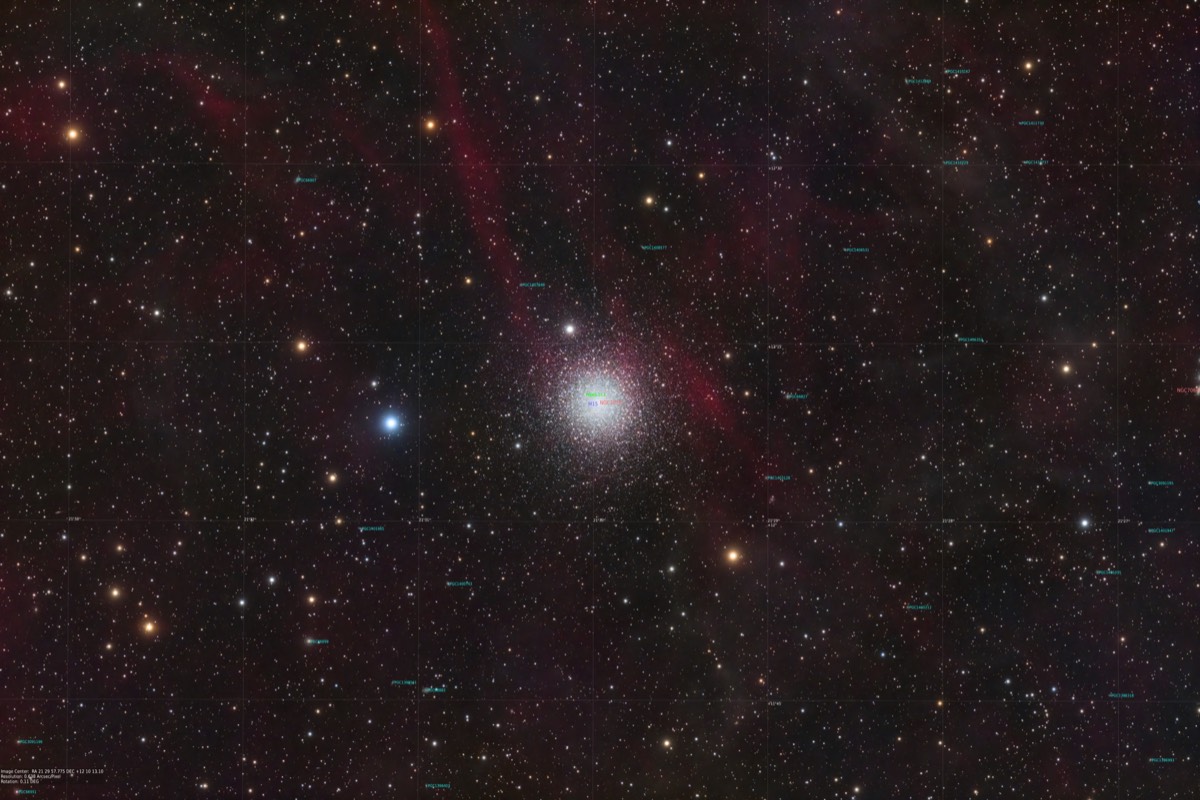Molecular dust and Hydrogen emission surrounding Globular Cluster M15
Published 25 Nov 2023
Full frame field of view

Zoom on M15

18.6hr 5nm Ha continuum subtracted image
Annotated Image
About this object: Courtesy of Sky Safari
With a total visual magnitude of 6.2, Messier 15 is among the more conspicuous of these great stellar swarms. It can be seen as a fuzzy star with binoculars or a small telescope. Instruments of at least 6 inches' aperture will start to reveal individual stars, the brightest of which are magnitude 12.6. This cluster is a fine, bright globular with a blazing core that thins rapidly from the center. Many arms and chains radiate from the core, out to a diameter of 18'.
Messier 15 lies approximately 33,600 light years from Earth and has a diameter of about 175 light years. Its tidal radius, beyond which member stars would escape because of the Milky Way's gravity is a bit larger: 210 light years. M 15 has an absolute magnitude of -9.2, which translates to a luminosity of 360,000 Suns. M 15 is estimated to be 13.2 billion years old, making it one of the oldest known globular clusters.
Messier 15 is one of the most densely packed globulars known in the Milky Way galaxy. The half-mass radius of M 15 is about 10 light years - half the mass of this cluster is concentrated in a sphere of that radius. M 15's core has undergone a contraction known as core collapse, which may indicate a black hole.
M 15 is the first globular cluster in which a planetary nebula, Pease 1, was identified, in 1928. To this date, Pease 1 is still one of only four planetary nebulae known in a globular cluster. Messier 15 contains over one hundred variable stars. It also contains at least 8 pulsars, including one double neutron star system.
M 15 emits X-rays; two bright X-ray sources were resolved by the Chandra X-ray observatory. These provide further evidence of a black hole at the center of M 15.
This image also includes less well known Ha emission, in red, around M15 and molecular dust. The molecular dust is most prominent on the right side, as an arc of grayish blue material.
Above is an image of the continuum subtracted Ha, where the starlight and continuum light has been removed showing only Ha emission and also some background galaxies which strongly emitted in the Ha spectrum.
In the annotated image above you can see quite a few catalogued background galaxies and if you click for the full res version also a lot of uncatalogued background galaxies.
I want to give a shoutout to Adam Block and Mike Cranfield. This image was put together using a new script called NBColorMapper that they developed for PixInsight Its a super easy and fun way to either add NB data to RGB images or building your own NB color image using the script. If your a PI user, you should check it out…
With a total visual magnitude of 6.2, Messier 15 is among the more conspicuous of these great stellar swarms. It can be seen as a fuzzy star with binoculars or a small telescope. Instruments of at least 6 inches' aperture will start to reveal individual stars, the brightest of which are magnitude 12.6. This cluster is a fine, bright globular with a blazing core that thins rapidly from the center. Many arms and chains radiate from the core, out to a diameter of 18'.
Messier 15 lies approximately 33,600 light years from Earth and has a diameter of about 175 light years. Its tidal radius, beyond which member stars would escape because of the Milky Way's gravity is a bit larger: 210 light years. M 15 has an absolute magnitude of -9.2, which translates to a luminosity of 360,000 Suns. M 15 is estimated to be 13.2 billion years old, making it one of the oldest known globular clusters.
Messier 15 is one of the most densely packed globulars known in the Milky Way galaxy. The half-mass radius of M 15 is about 10 light years - half the mass of this cluster is concentrated in a sphere of that radius. M 15's core has undergone a contraction known as core collapse, which may indicate a black hole.
M 15 is the first globular cluster in which a planetary nebula, Pease 1, was identified, in 1928. To this date, Pease 1 is still one of only four planetary nebulae known in a globular cluster. Messier 15 contains over one hundred variable stars. It also contains at least 8 pulsars, including one double neutron star system.
M 15 emits X-rays; two bright X-ray sources were resolved by the Chandra X-ray observatory. These provide further evidence of a black hole at the center of M 15.
This image also includes less well known Ha emission, in red, around M15 and molecular dust. The molecular dust is most prominent on the right side, as an arc of grayish blue material.
Above is an image of the continuum subtracted Ha, where the starlight and continuum light has been removed showing only Ha emission and also some background galaxies which strongly emitted in the Ha spectrum.
In the annotated image above you can see quite a few catalogued background galaxies and if you click for the full res version also a lot of uncatalogued background galaxies.
I want to give a shoutout to Adam Block and Mike Cranfield. This image was put together using a new script called NBColorMapper that they developed for PixInsight Its a super easy and fun way to either add NB data to RGB images or building your own NB color image using the script. If your a PI user, you should check it out…
Image Details
- Optics : Stellarvue SVX 152T refractor @f8 1200mm FL
- Mount: Paramount MYT
- Camera: ZWO ASI6200
- Filters: Chroma 50mm RGB, Astrodon 50mm 5nm Ha filter
- Exposure (min): HaRGB 940:120:120:120 21.6 hrs, 2x2 binning, drizzled to 1x1 bin size
- Automation Control: The Sky X, Voyager Advanced, PrimaluceLab Eagle 4 pro
- Guiding: StarlightXpress Lodestar X2
- Processing Software: PixInsight, PS CC
- Location: Stark Bayou Observatory, Ocean Springs, MS
- Sky: Typical SQM 19.3-20.1, Bortle 5, Suburban
- Date: 21 Sep - 8 Nov 23








